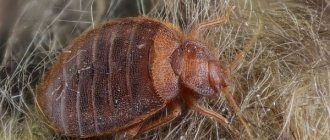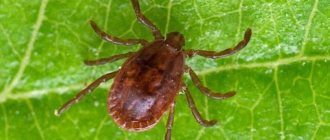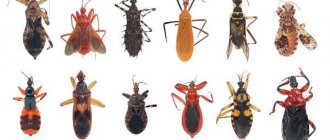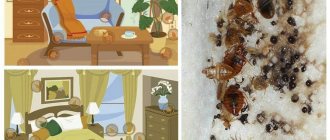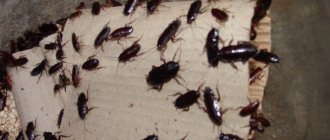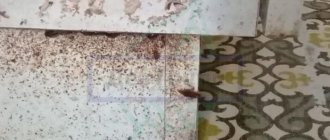Bed bugs are insects that have different life stages. We usually worry about nymph and adult bed bugs because these are the life stages of the house bug when it bites us. However, the first stage of an egg's life is one of the most difficult stages to not only find, but also kill embryos.
In this article I will tell you where bedbugs lay their eggs. You will learn what eggs look like and see bed bug eggs in photos, learn where they can be found, and how to achieve their complete destruction.
Before deciding how to destroy bedbug eggs, study the photo to see what it looks like. Bedbug eggs are very small in size. They are only about one millimeter long and are not pure white.
To get an idea, imagine about half a grain of white rice.
What do bedbug eggs look like?
The shape of the eggs looks like a grain of rice, but if the larva has already hatched and left its home, then it is hollow.
Identification marks of eggs:
- the color can vary from transparent and white to light yellow, it depends on the stage of development of the embryo;
- elongated, oval shape;
- have a slight bend;
- at the tip they have a lid, which the young individuals open when they go outside;
- the shell is covered with an adhesive and viscous substance, as a result of which the egg can stick to any surface.
Eggs are sometimes unknowingly confused with bedbug feces, which are dark in color and much smaller in size. Eggs are usually laid in clutches of 5-12 pieces, with one embryo containing one embryo.
What size are bedbug eggs?
Bedbug eggs are small in size; it is not always possible to see them without a magnifying glass; their length ranges from 0.5 to 1 mm.
How do bedbugs lay eggs?
The peculiarity of bedbug reproduction is traumatic mating. The female does not have external genitalia, so the male pierces the wall of the abdominal cavity and injects seminal fluid into it. It is stored in a special compartment and used as needed. To create new clutches, females no longer need a sexual partner; they use the reserves of seminal fluid stored inside her body.
At the posterior end of her body there is an ovipositor, where eggs are formed within 5 days. The female then begins to lay up to 12 future eggs per day. And over a lifetime, from 300 to 500 pieces. The rate of reproduction and fertility of parasites depends on temperature factors and the quality of nutrition. One meal can enable the female to lay up to 20 eggs two days later.
Life cycle of eggs
First, the formation of eggs occurs in the female’s body, after which she lays eggs and the development of the future bug continues.
How bedbugs lay eggs
Growth cycle.
Mating of bedbugs occurs using a traumatic method, because the female lacks external genitalia. The male pierces her abdomen, injecting seminal fluid. The substance is located in a separate area and is applied at the moment when it is needed. After receiving the seed, the female does not need to mate again to produce offspring. She uses the fluid reserves that are stored in her body.
In the posterior region of the female's body there is an ovipositor in which eggs are formed. When laying eggs, the parasite is capable of laying up to 5 eggs per day, and during its entire existence - 200-500 eggs. The reproduction and fertility of the female is influenced by environmental conditions. Two days after eating, the insect will produce offspring.
Egg maturation period
The air temperature in the infected room affects the incubation period, which varies from 4 to 17 days. In a minimum period of time, the egg will ripen at a suitable temperature, which is +30°C.
As the temperature decreases, the duration of incubation increases. When the temperature reaches +15°C, embryo development stops. Temperature conditions within +25…+35°C are suitable for ripening.
How long do eggs live?
The life of eggs depends on the place of laying and the space surrounding them. At low temperatures, nymphs will appear later. It was possible to find out that the viability of the masonry in this case lasts up to 100 days.
In the shell, which is a kind of incubator, favorable conditions are maintained for the development of the individual. The density of the shell protects the embryo from exposure to most chemicals.
How many days do they hatch?
The emergence of larvae from the clutch occurs at least after 4-7 days. On average, the time until hatching is 4-25 days. This period depends on the temperature and humidity of the room.
How long does it take for bedbug larvae to hatch?
It is important to know how many days it takes for a new generation of bedbugs to hatch, they hatch from eggs approximately 5-24 days after they were laid, and sometimes as long as 3 days. Such a large interval is indicated because the rate of development of embryos in eggs depends on temperature and air humidity.
The higher the temperature, the faster the eggs mature. Favorable ambient temperature for eggs is from +21 to +30°C. The development of the embryo in such conditions is rapid and they are born in 3-7 days.
A temperature of +10°C helps slow down the development of the embryo. The larvae will appear only after 2-3 weeks.
When the indicator drops to 0°C, the process stops completely and after a week the embryo dies.
If the humidity is very low or high, the larva will not be able to break through the shell and will also die.
In a modern living space, the most favorable environment for the development of eggs, which usually occurs within 10 days.
Destruction methods
Since the shell of bedbug eggs has protective functions, in most cases chemical methods of controlling these insects are ineffective. But there are other methods to destroy these parasites in their rudimentary form. Based on the fact that insects do not like high humidity, as well as too low (below -15˚C) and excessively high (above 65˚C) ambient temperatures, you can use the thermal method.
Its essence is to influence egg laying with steam or boiling water. Freezing can also be used. Bed linen must be boiled for twenty minutes. Clothing must be subjected to the same heat treatment. Mattresses and upholstered furniture should be treated with boiling water, iron or hot steam.
Tags: hatch, bug, how much, through, egg
About the author: admin4ik
« Previous entry
Why are bedbug eggs dangerous in an apartment?
Bedbug eggs are the most important problem, because of which they cannot always be destroyed indoors the first time. Even if the owners of the apartment have taken measures to ensure that parasites do not get in from neighbors, and even if bedbugs are poisoned in a private house, it is because of the eggs that most often it is necessary to carry out repeated treatment.
Bedbug eggs mixed with empty shells and excrement
The point here is that there are no insecticides on the market today that would definitely and completely kill the embryos in bed bug eggs. And almost always, after treatment, it is the bedbug eggs that remain viable.
Consequently, if at the time of treatment there are previously laid eggs in the room (and they almost always are), then after treatment they will hatch into larvae that will have a chance to survive, start biting people, grow and restore the population here.
However, this problem can usually be easily resolved. If you know the specifics of the development of bedbug eggs and larvae, it is relatively easy to destroy them all, including the larvae, which only hatch later. Moreover, in most cases this can be done in one treatment and there is no need to deal specifically with bedbug eggs in any additional way. What do you need to know for this?
The essence and procedure for reprocessing
This treatment is much simpler than the first. Simply because such small larvae are much more sensitive to the drugs used and die faster, plus they all concentrate near the sleeping areas. They are very small and cannot move quickly like adult bedbugs, and therefore after biting they hide in close proximity to a sleeping person - on mattresses, on sofas, on beds, and the like.
For example, nymphs of the first instar simply cannot leave behind the baseboard - they will not have time to reach a sleeping person from here in a whole night. Therefore, all this young generation is in and near the sleeping places, where it is quite easy to poison them all.
The most important thing in such re-processing is to choose the right time. On the one hand, at the time of its implementation, larvae should already hatch from all the eggs, on the other hand, by this time not a single nymph should have time to turn into an adult bug.
The development period of eggs is 12 days, nymphs turn into adults in 28-30 days. At this age - about a month after hatching - they begin to lay eggs themselves. Therefore, the treatment must be carried out exactly within this period - from 12 to 28 days after the first disinfestation.
In practice, it is better to do this as early as possible. Just so that the parasites bite less people. We carry out repeated treatments only if necessary, if bedbugs begin to bite people after the first treatment, and approximately 2 weeks after the first.
According to our internal statistics for the entire DisinCity company, the need for this arises in approximately 17% of cases.
Simply put, for every 6 treatments after which the bedbugs disappear immediately, there is one such treatment, after which the room needs to be treated again. This is fine.
What do bed bug eggs look like?
The photo below shows bed bug eggs:
Bedbug eggs on days 6 (left), 8 (center) and 10 (right) of development
Here they are shown at a very close zoom. It can be seen that they are whitish in color, elongated in length. Their length is about a millimeter, their diameter is about a third of a millimeter. The egg in which the embryo develops is translucent, with a visible embryo inside. The shell from which the larva has already hatched is simply dull white.
It is important to understand that the eggs in the photo look completely different from how they look on a real sofa or mattress. The photo is usually taken with a strong zoom and magnification so that the egg on it can be comfortably seen. And in real home conditions, from a distance of 30-40 cm, eggs are lost against the background of debris in a bedbug nest, against the background of fabric or white plaster.
Bedbug nest on sofa frame
Basically, for the sake of simplicity, think of these eggs as being like small, long grains of rice. Each female lays 250-500 eggs in her life, and she does this every day, laying 2-3 eggs per day.
It is therefore obvious that eggs are almost never found alone. After being saturated with blood, the female does not feed for 3-4 days and remains in one shelter, laying 10-12 eggs here. The result is a kind of clutch, although the insect does not make any systematic arrangement of the eggs and does not try to somehow hide or disguise them.
Typical picture when separating the upholstery of an infected sofa from the frame
And yes, do not confuse bedbug eggs with their excrement. The latter look like black dots, and the eggs are white and elongated. In this case, the egg during oviposition is enveloped in a sticky secretion, which hardens over time and the egg becomes glued to the surface. Therefore, simply brushing the masonry off the mattress or sofa will not work. They can only be scraped off with a fingernail or some other tool.
Bedbug eggs in an ordinary apartment
Firstly, bedbug eggs are present in all rooms in which these bedbugs more or less regularly bite people. If there is more than one bedbugs, they will multiply and eggs will appear in certain places. Just because you don't see or find them doesn't mean they aren't here.
If the “lid” is closed on the egg, it means that the larva is still developing inside.
Secondly, bedbugs lay the bulk of their eggs where it is damn difficult to get to them. Here, when exterminators inspect a room and prepare it for treatment, they most often find eggs in places where an ordinary person trying to destroy bedbugs on their own would not even look. Typically, masonry is located behind the baseboards, between the boards of the bed frame and sofa, behind the ceiling moldings. If bedbugs were able to get into the filling of a sofa or mattress, then the eggs will be there too.
In other words, the more difficult it is for you to inspect a place, the more likely it is that bedbug eggs will be found there. This is partly why many people don't find them. They look only where it is easy to look - at the mattress from above, at the walls of the sofa, at the same baseboard, only from above, and they see nothing. And you need to look at the seams of mattresses and sofa upholstery.
If you lift such a seam, then it is on the fold under it that you will be able to see eggs, excrement, small nymphs, and sometimes adult bedbugs. You need to unscrew the sofa or bed and inspect all the parts, including fasteners - washers, bolt heads, hinges. You need to unfasten the baseboards from the walls and look at both the baseboard itself and the wall behind it. It is also advisable to lift linoleum or laminate flooring - if there are cracks under them, there may also be eggs there. And so on - in a separate video we talked about where bedbugs can hide in an apartment. Look at it and check all these places - books, shelves, sockets, back walls of furniture, ceiling moldings, household appliances. Most likely you will find eggs.
On a note
Bedbugs cannot lay eggs on humans. They lay eggs only in quiet, hard-to-reach places where they live themselves and into which people rarely look and where the eggs are as safe as possible. There is no such security on the human body or in the body itself. In addition, in their life activities, bedbugs try to minimize contact with people, climbing onto a person’s body for a very short period of time to drink blood, and then crawling into shelters, that is, for them the feeding process is very dangerous and restless. But the main thing is that bedbugs physically cannot lay an egg in the human body; for this they do not have special stylet-shaped oviducts, with the help of which other insects (for example, ichneumon ichneumon fly) perform similar operations. As a result, there are no known cases in which bedbugs would lay eggs not only in the human body, but even on it.
Third: due to the fact that eggs are often located in very hard-to-reach places, they can be extremely difficult to get even with the means by which they can be destroyed. For example, it is impossible to pour boiling water inside the upholstery of a sofa, and somewhere in the gap between the door frame and the wall it is impossible to crush eggs even with a knife.
That is why, in most cases, it is advisable and most effective not to try to get rid of the bedbug eggs themselves, but to take measures to destroy those nymphs that hatch from these eggs. Killing these nymphs is much easier than destroying the eggs, and in most cases, a properly carried out first treatment will ensure that even after this, such hatching larvae will be destroyed.
How to poison young nymphs
There are nuances here regarding the means used for processing. We remind you: there are no drugs on the market today that are guaranteed to destroy bedbug eggs. Some drugs seem to show an ovicidal effect, but no evidence can be found, about other products the sellers themselves say so, but, again, they cannot prove anything, but in fact, a drug that would undergo full testing and show an ovicidal effect, No.
Therefore, for treatment, you need to purchase not a product from which the seller promises an ovicidal effect, but a product that remains active after drying, that is, has a residual effect. The majority of such drugs are - almost all organophosphorus compounds, neonicotinoids, pyrethroids poison bedbugs after drying.
Exterminators against bed bugs use organophosphates or neonicotinoids, sometimes more exclusive drugs. For household use, this is Karbofos, for example, Fufanon, Executioner, Get.
Modern drugs called Dichlorvos, as well as such popular drugs as Tsifox or Medilis Cyper, contain cypermethrin or other pyrethroids and it is better not to use them against bedbugs.
It is necessary to treat the apartment with preparations based on FOS so that the product remains on the maximum number of surfaces - on the back walls of furniture, on baseboards, on the bed frame, even on the mattress - wherever bedbugs can come into contact with it. You will cover the same mattress with a clean sheet, you will not come into contact with it yourself, but the bedbugs will run on it. And they will be poisoned.
It is important not to wash off the product from surfaces after treatment. The longer it stays here, the more bedbugs will die from it and the more likely you will not have to poison them again.
Why are eggs so difficult to destroy?
The egg itself protects the embryo very well from various external influences. Through the shell of the egg there is very little gas exchange with the environment and toxic substances do not penetrate inside. Even if the outside of the egg is sprayed with a product and the product dries on it, the larva will not come into contact with the drug when emerging from the egg.
The fact is that it hatches through the upper narrow side of the egg; there is even a special cap that the larva pushes out to get out. So she pushed the lid out, got out and left, without even getting dirty in the product that was on the surface.
Actually, this is exactly what happens after disinfestation. The handler sprays the product over all the places where bedbugs are found, including all the eggs (if he is a good exterminator who has previously opened all these places). Adult bedbugs and nymphs that were in the apartment at the time of treatment die. At the same time, there are eggs in the apartment that survived the persecution.
Consequently, after disinfestation, larvae begin to hatch from those eggs that were laid first, and gradually over a week or two, larvae hatch from all eggs. After 2 weeks, there are no developing eggs left in the room. Either egg shells or larvae remain here. There are no adult bedbugs here that could lay new eggs - we destroyed all of them during processing.
Please note: we are now talking, let’s say, if not about an ideal situation, then about a very good one, in which we are absolutely sure that new bedbugs are not getting into the room from the neighbors. That is, this is either a separate private house, or an apartment with excellent repairs, where bedbugs cannot get in from neighbors and into which they were accidentally brought by people.
If neighbor bugs can get into the room, then even before the larvae hatch from all the eggs, adult insects can get in here and begin laying new eggs. But let’s say we really have a room where bedbugs don’t get into.
What happens to eggs after conventional processing (and does anything happen at all?)
If there were not very many bedbugs before treatment, and the baiting was carried out with a product that has a residual effect, then all the young larvae die from this product. These larvae are very small, crawl slowly, and when they hatch from the eggs, they immediately land on surfaces on which a layer of dried preparation remains. Since they move slowly, they come into contact with this drug for a long time, become heavily soiled in it, it affects them and they die. If the treatment was carried out really well, then all newly hatched larvae are destroyed in this way. That is, people do not even have time to see these newly hatched larvae and repeated disinfestation is no longer required.
Indeed, problems arise when either there were a lot of bedbugs before the first treatment, or during treatment, agents without a residual effect were used (as a rule, various folk remedies), or the treatment itself was carried out poorly. In all these cases, some of the larvae survive.
If there were a lot of bedbugs, they left a huge number of eggs, many larvae hatched from these eggs, and some isolated nymphs avoided contact with the product, or were resistant to it, and did not die. If the product has no residual effect, then all the young bloodsuckers will run through it without harm to themselves, will grow and eventually mature and begin to reproduce.
The same thing will happen after poor-quality treatment: many surfaces will remain untreated and the larvae simply will not come into contact with the product. And therefore, they will not die.
In all these cases, after 5-6 days, the bugs begin to bite people again. They do not bite very aggressively and not very often, since there are few of them and they are all small larvae that bite weakly and little by little. However, these bites are felt, and if they appear, the treatment must be repeated.
What do bedbug eggs look like and their features - photo
The laying of bedbug eggs looks very much like scattered grains of rice. The main identifying features are:
- small size within 0.5-1 mm;
- transparent white and light yellow color, depending on the stage of development of the embryo;
- elongated oval shape;
- a small bend and a “lid” in the part from which the mature individual will appear;
- an adhesive substance that covers the entire shell, serving as the basis for holding the masonry on any surface.
REFERENCE. Bed bug eggs can easily be confused with their droppings. A characteristic feature of the latter is its dark color.
How and how long do bedbugs lay eggs?
The process of conception in bedbugs occurs through traumatic insemination: the male injects sperm into the abdomen of the female by puncture. 4-5 days after this, the female is ready to lay eggs. She is capable of producing up to 12 eggs per day, and lays up to 500 eggs in her entire life. eggs Coming out of the wearer's body, they are lubricated with an adhesive liquid, which ensures reliable fixation on the surface.
IMPORTANT. The female mates only once. The resulting seminal fluid is stored inside her body and is used for fertilization or nutrition.
How long do eggs live?
Insects appear 5-10 days after egg laying. This period of time depends on environmental conditions. If the house is cold, the rate of larval development slows down and hatching is delayed by several weeks.
REFERENCE. After the birth of young individuals, the empty clutch remains in place and is easily confused with fresh eggs.
How many bedbugs hatch from one egg?
The number of young insects is equal to the number of eggs in the clutch, i.e. 1 bug comes out of 1 egg. Each clutch consists of a maximum of 12 eggs.
ATTENTION. The high rate of reproduction of bed parasites is due to their adaptability to living conditions and the fertility of females.
How long does it take for eggs to hatch and become larvae?
The approximate hatching time of blood-sucking larvae ranges from 1-2 weeks. Under the influence of external factors, it decreases or increases. The newly born individual has minimal dimensions (up to 1.5 mm), but the external structure is no different from an adult insect: antennae and 3 pairs of legs.
At what temperature do they die?
Bed bugs do not respond well to temperature fluctuations. They are physically unable to tolerate cold (below -10°C) and heat (above +45°C).
REFERENCE. This feature is used to kill parasites.
Reproduction rate
Having information about how long these parasites live and how many eggs a female can lay, it is easy to calculate their reproduction rate. The lifespan of a bug is 1-1.5 years, during which time it lays from 250 to 500 eggs. Using simple arithmetic calculations, we will find out how many insects will be in the apartment just 3 months after the only parasite got there.
We suggest you read: Cucumbers on the windowsill: tips on how to grow them at home
If the house is cool, people rarely spend the night or access to them is difficult, each stage of development will take:
- egg – 20 days,
- larva – 2 months,
- adult until first laying – 1 week.
After six months, the number of bedbugs will be about 1.5 thousand.
Now let’s calculate how quickly bedbugs reproduce under the most comfortable conditions:
- egg - 4 days,
- larva – 28 days,
- adult until first laying – 3 days.
After 35 days there will already be 40 bedbugs, and after 3 months the insect population will reach tens of thousands. It is the rapid reproduction of bedbugs that explains their massive invasions.
How to destroy bedbug eggs in an apartment
Disinfection.
Eliminating pests from your home is not an easy task. Adults are poisoned with insecticides, but the egg clutch is resistant to many chemicals. Insects can be eliminated mechanically, using chemicals or using the temperature method.
Mechanical cleaning
This method of eliminating blood-sucking parasites does not guarantee their complete destruction, but it is the simplest. To do this, you will need to find the eggs and crush them, after putting gloves on your hands, or collect them and burn them. The effectiveness of the technique is not very high due to the location of the oviposition in places that are difficult for humans to reach.
Chemical methods
An ovicidal agent that kills bedbug eggs is an appropriate choice. These include “Fufanon” and “Karbofos”, which have a low cost. They can be purchased at a hardware store. The disadvantage of the poison is increased toxicity and disgusting odor. “Get” and “Lambda Zone”, which are produced in the form of microencapsulated concentrates, have a similar effect. To carry out the treatment, you need to prepare gloves, a respirator and goggles.
The Delta Zone, which has a strong smell, will help kill parasite eggs. There are radical substances, when working with which they use all measures to protect the body and internal organs.
These poisons include:
- "Chlorpyrimark";
- "Tetrix";
- "Sichlor";
- "Sinuzan."
Spraying them leads to the appearance of an unpleasant odor. The most powerful is Diazinon, but due to its high toxicity it is rarely used. The use of professional or microencapsulated products most often does not require re-processing. If you use “Dichlorvos” or “Kombat”, then the room is treated several times, taking a break between cleanings for 7 days.
The hot steam treatment method involves the use of an insecticide and high temperature. Such actions allow you to destroy the chitinous shell and kill the bed insect. When parasites have been living in a house for a long time, they carry out a thorough treatment, spraying all interior items, cracks and corners.
Thermal cleaning
We are cleaning the apartment.
This method of eliminating bedbugs involves the use of high and low temperatures. Boiling is suitable for cleaning clothes. The procedure takes at least half an hour. Hot steam, boiling water or iron are suitable for processing furniture and mattresses. During the cold season, things and furniture are taken out of the house and left outside for 24 hours. In this case, the temperature should not be higher than -20°C. After exposure to temperature, the furniture is washed with hydrogen peroxide.
The wallpaper torn from the wall is treated with steam and glued in place. Eliminating pests is a long and difficult process, so cleaning must be done thoroughly. If you neglect the treatment, the bloodsuckers will appear again. In some situations, despite all the effort and expense put in, bedbugs still begin to multiply in the apartment.
Then they turn to specialists and involve neighbors, if they exist. Practice has shown that if the room temperature is maintained at +40°C for about a day, both the adults and the eggs will die out. For bloodsuckers to quickly die, it will take 95 minutes at +45°C for adult bedbugs and 72 minutes at +48°C for eggs. To carry out such treatment, you will need a special apparatus and sensors to maintain the temperature in the room for the required amount of time and at the same level in all areas of the room.
Prevention of insects
It is much easier to prevent the appearance of domestic endoparasites than to try to get rid of them. Preventative measures include:
- the use of folk repellents;
- regular cleaning;
- processing things when returning from the resort.
Insecticides can also be used for prevention. If neighbors have nests and clutches of parasites, treatment is carried out regularly. In this way, it is possible to significantly reduce the likelihood of insects appearing in the apartment.
Important! Insects can even appear in new buildings. If after using powerful chemicals the parasites still return, you need to look for the source of their appearance.
Eggs, larvae and mature blood-sucking parasites bring a lot of inconvenience to humans. In most cases, they can only be removed using insecticides in combination with thermal or mechanical action. Only qualified specialists can perform all actions correctly. To quickly get rid of insects in the house, they call the sanitary and epidemiological service.
At what temperature do bedbug eggs die?
Changing environmental conditions negatively affects the condition of parasites. They reproduce less actively. With slight fluctuations in temperature, the lifestyle of parasites does not change, especially if access to a food source is open.
Bed bugs are affected by significant increases or decreases in temperature.
Critical temperature below zero
Insects at various stages of development, including those inside protective shells, die instantly if exposed to a temperature of at least -30°C. When environmental conditions change less significantly - to -7°C below zero, the parasites in the eggs will die after 1.5 months.
It's possible
provided that this temperature is maintained for a long time and on a regular basis.
Critical temperature above zero
The death of insects occurs at temperatures from +55°C and above. In such conditions, parasites die immediately. If the temperature is maintained at +45...+50°C, the death of bedbugs occurs within 24 hours.
The critical temperature for bedbug eggs is +45°C or higher
How to fight parasites?
Routine treatment of the premises with insecticides will help effectively destroy adult individuals. However, such products do not harm the eggs. As a result, after some time, new parasites hatch. But how to get rid of bedbug eggs? It is recommended to do the following:
- It is necessary to carefully examine the places where parasite nests may be located. Infested areas should be steamed to remove excrement and eggs from the surface. Bed linen must be boiled for 30 minutes.
- Crevices, baseboards, and cracks in furniture must be treated with a special mixture of 20 ml of kerosene, 150 ml of boiling water, 15 ml of turpentine.
- In winter, upholstered furniture, mattresses, and pillows can be taken out into the cold, leaving them in the fresh air for a day. Insects die at low temperatures. Afterwards, the item should be washed with soda solution or hydrogen peroxide. It is recommended to ventilate the apartment. By the way, in this article we wrote at what temperature bedbugs die and how effective it is.
Bedbugs, their larvae and even eggs die in severe frost
If numerous treatments of the room do not bring results, then it is worth discussing this problem with your neighbors. After all, parasites can enter the apartment precisely from them.
If you were unable to eliminate the bedbugs on your own, you can turn to exterminators. Specialists use modern and effective means to combat parasites, so they will completely eliminate insects. Read how disinfection works and how long the effect lasts here.
See also: How to deal with bed bugs?
...and is it possible to kill them without insecticides?
Eggs can definitely be killed by high temperatures. Adult bedbugs die at +45 degrees in 45 minutes, and at +50 in 10 minutes. It is not known how quickly eggs die at these temperatures, but boiling water and steam from a steam generator or a simple iron kills them instantly. That is, if you use a steam generator to treat a mattress with eggs on it, no one will hatch from these eggs.
Another thing is that you can’t get to many places where eggs are located either by steam or by boiling water. For example, behind the same skirting boards, if they are not removed, or under linoleum. And, for example, books on shelves cannot be treated with boiling water at all, although bedbugs often settle there, including in bindings. That is why, despite such effectiveness, it is usually not possible to destroy all bedbug eggs in a room using either boiling water or steam.
If eggs are found on bed linen, this linen can be washed in water at 55-60 degrees. With this type of washing, the eggs will die, and in the washing machine they will be washed off from the fabric.
But mechanically crushing the eggs or simply removing them from the furniture will not work. When laid, they are covered with a sticky secretion, which sticks to the surface. This protects them from simple swiping, for example. It is also difficult to crush them due to their small size - somewhere under a fold of upholstery or a seam of a mattress, it is simply impossible to press them with your finger. But the main thing is different: it is almost impossible to find all the eggs in the apartment, because they can be “scattered” literally in all the small crevices and are not noticeable everywhere.


